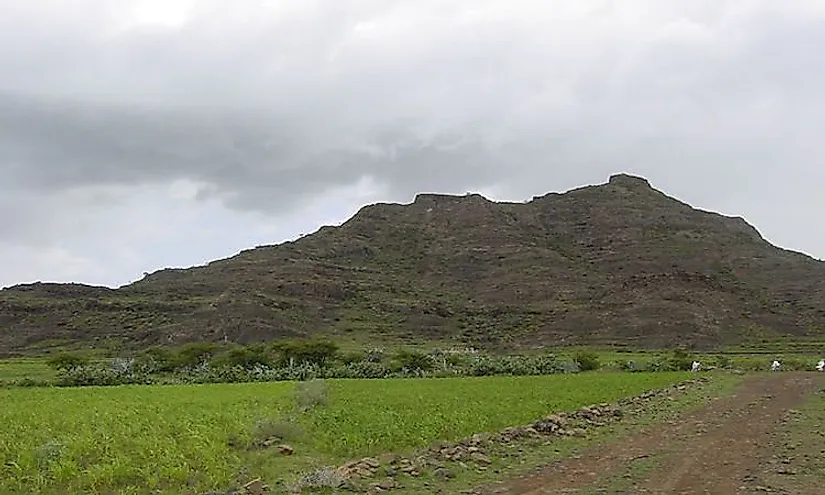Ecological Regions Of Eritrea

Eritrea has a broad range of climatic and ecological variations relative to its geographic size. Eritrea lies on the coastline of the Red Sea and borders Ethiopia, Sudan, and Djibouti. Eritrea is comprised of a central highland mass which divides the country into its western and eastern lowlands. The following are the ecological regions of Eritrea.
Ecological Regions Of Eritrea
East Sudanian Savanna
The East Sudanian savanna is classified in the Tropical and Subtropical Grasslands, Savannas and Shrublands Biome. The ecoregion is native to East and Central Africa. This ecoregion is hot and dry and is characterized by elephant grass and Terminalia and Combretum tree and shrub species. The ecoregion has a tropical climate with a dry season and a rainy season between April and October.
The ecoregion has mainly deciduous trees, which support an undergrowth of herbs, grass and shrubs. Bird species which inhabit the region include the Karamoja Apalis, Fox’s Weaver, and the white-crowned robin-chat. A mouse is the only endemic mammal in the area alongside other mammal species such as the wild dog, lion, and leopard. The ecoregion has been listed as Critical/Endangered due to threats from hunting, fires, agricultural practices, deforestation, and overgrazing.
Eritrean Coastal Desert
The Eritrean Coastal Desert is classified in the Deserts and xeric shrublands Biome. This ecoregion stretches along the southern coastline of the Red Sea from Ethiopia to the shore of Djibouti. The ecoregion has a hot and dry climate and receives an average of less than 100 mm of rainfall. Mean minimum temperature and maximum temperatures are 27 and 33 degree Celsius respectively. The region is mostly a sand or gravel plain, with rocky regions along the coastline, sandy beaches, and coral reefs.
Herbs and grasses dominate the region including Panicum turgidum, Aerva javanica, and Lasiurus scindicus. The ecoregion is one of the world’s most important hubs for raptor migration. The steppe eagle and the steppe buzzard are the most common raptor species. The region does not have abundant fauna except for species such as the Dorcas gazelle, Salt’s dik-dik, and Soemmerring’s gazelle. The ecoregion is largely devoid of human interference due to the extreme conditions. Poaching and infrastructure developments are some of the identified potential threats.
Ethiopian Montane Moorlands
The Ethiopian Montane Moorlands ecoregion is classified in the Montane grasslands and shrublands Biome. The ecoregion lies within the higher altitudes of the Ethiopian Highlands, from about 3,000 meters to above 4,500 meters. The highest rainfall is recorded to the region’s southwest, at an estimated 2,500 mm. The region’s winter months are between November and March when frosts occur.
Vegetation in the area is mainly comprised of herbs, grassland, and moorland. Plant species of Primula and Rosa are common in the region. The ecoregion is notably home to the highly threatened Ethiopian wolf and the giant mole-rat endemic rodent. Other rodents in the region are the Ethiopian narrow-headed rat and the black-clawed brush-furred rat. Overgrazing, human encroachment, fires, and land transformation are some of the environmental threats identified in the region.
Ethiopian Xeric Grasslands And Shrublands
The Ethiopian Xeric grasslands and shrublands ecoregion is classified in the Deserts and xeric shrublands Biome. The ecoregion stretches along the Red Sea’s coastline from Eritrea, Ethiopia, and Djibouti to Somalia. Earthquakes are common in the region, which is related to the ongoing enlargement of the Rift Valley. The region also has numerous active volcanoes. The ecoregion has a dry and hot climate, with annual rainfall ranging from 200 mm inland to 100 mm along the coastline. Mean maximum temperatures are estimated at 30 degrees Celsius while mean minimum temperatures occur between 21 to 24 degrees Celsius.
Mammal species roaming the ecoregion include the Somali Wild Ass, Dorcas gazelle, Beisa oryx and Beira. Agricultural practices, overgrazing, and deforestation, are emerging threats although there are plans to establish a protection reserve in Eritrea.
Concerns And Conservation
Other ecoregions in Eritrea are Ethiopian montane forests; Ethiopian montane grasslands and woodlands; Sahelian Acacia savanna and Somalia Acacia-Commiphora bushlands and thickets. Ecoregions in Eritrea are largely unprotected, a situation which has raised concerns over their sustainability. The government of Eritrea in collaboration with the United Nations has been on a mission to establish conservation reserves in the country.
Ecological Regions Of Eritrea
| Ecological Regions of Eritrea | Biome |
| East Sudanian savanna | Tropical and Subtropical Grasslands, Savannas, and Shrublands |
| Eritrean coastal desert | Deserts and Xeric Shrublands |
| Ethiopian montane forests | Tropical and Subtropical Moist Broadleaf Forests |
| Ethiopian montane grasslands and woodlands | Montane Grasslands and Shrublands |
| Ethiopian montane moorlands | Montane Grasslands and Shrublands |
| Ethiopian xeric grasslands and shrublands | Deserts and Xeric Shrublands |
| Sahelian Acacia savanna | Tropical and Subtropical Grasslands, Savannas, and Shrublands |
| Somali Acacia-Commiphora bushlands and thickets | Tropical and Subtropical Grasslands, Savannas, and Shrublands |











